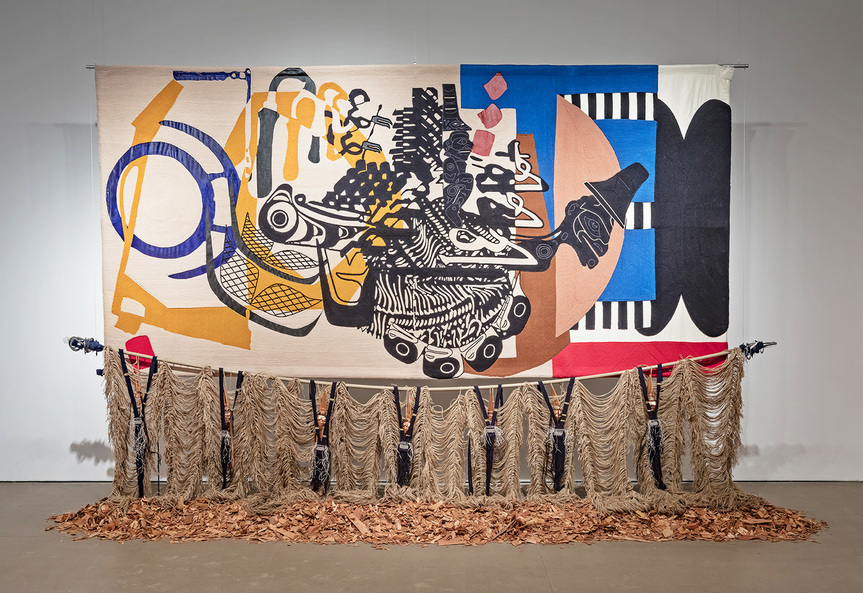-
From Current Issue
-
- Editor’s Letter Fire in the Heart
- Reviews I Gusti Ayu Kadek Murniasih
- Reviews 11th Seoul Mediacity Biennale: “One Escape at a Time”
- Dispatch Networked China
- One on One Monira Al Qadiri on Yukio Mishima
- Essays The rise of independent art spaces in pandemic-era Shanghai
- Features Tuan Andrew Nguyen
- Table of Contents
- Web Exclusives
- Archive
- Subscribe

R
E
V N
E
X
T
Installation view of NIRBHAI SINGH SIDHU’s “Medicine for a Nightmare (they called, we responded)” at Mercer Union, Toronto, 2019. All photos by Toni Hafkenscheid; courtesy the artist.
Writer and activist Bayo Akomolafe once said that to honor the past is to acknowledge that it is constantly generative. Scarborough-based artist (Nep) Nirbhai Singh Sidhu’s solo exhibition, “Medicine for a Nightmare (they called, we responded),” at Toronto’s Mercer Union, was a continuation of Sidhu’s investigation into the contemporary era’s historical inheritance. Along with curator cheyanne turions, Sidhu assembled a collection of tapestries, sculptures, and jewelry work that are as much monuments to the knowledge that has been passed down from preceding generations, as they are creative gestures that disrupt the continuity of history. In navigating collective loss, Sidhu reconfigures the future potential of the past and envisions communal resilience.
To heal is to look beyond trauma and re-evaluate the weight that it carries. In reconsidering the monumental, Sidhu erected a temple in the back gallery at Mercer Union. Built out of cement and firmly pressed against a pedestal of soil, Formed in the Divine, Divine of Form (2019) resembles a futuristic monolith that has been laid out for burial or is emerging from repose. The structure references the Harmandir Sahib, also known as the Golden Temple, in Amritsar, India—one of the most important gurdwaras in Sikhism and the site of an oft unspoken violence. In 1984, the Indian-military-led Operation Blue Star resulted in the massacre of Sikh people in Harmandir Sahib and the destruction of Sikh knowledge, history, and community. For Sidhu, cultural knowledge can be interrupted, erased, and attacked, but materials hold memory with austerity and poeticism. In Formed in the Divine, Divine of Form, Sidhu’s intimacy with material practice swoons with propositional quality as he creates a carrier for alternative knowledge. Traces of a happening, past or yet to come, are embedded in the temple: a gathering of steel blades stand vigil, flower petals float in a shallow pool, and a brass circuit leads to a hand-shaped imprint. The palm bears a small inscription that reads “Ek Onkar,” a symbol representing one’s supreme reality and a boundless faith rooted in care and preservation. An accompanying ambient soundscape by Slow Riffs plays overhead, with beginnings and endings that merge into unending melodies. Drifting between affective layers of history, Sidhu proffers a gathering space for healing, foregrounding and reinscribing the past while summoning a passageway across its threshold.
Installation view of NIRBHAI SINGH SIDHU’s Formed in the Divine, Divine of Form (foreground), 2019, concrete and brass, 254 × 244 × 71 cm, and Seva, In Memory, In Practice (background), 2019, 274 × 366 cm, at “Medicine for a Nightmare (they called, we responded),” Mercer Union, Toronto, 2019.
In the front gallery were two tapestries, including Axes in Polyrhythm (2018). Like many of the other displays in the exhibition, the work was made collaboratively, in this case with Nicholas Galanin, Sidhu’s fellow Black Constellation art collective member. Sidhu sees artistic partnerships as shared agency—crucial for mapping and community healing. Axes in Polyrhythm partially abstracts iconography from totem poles, incorporating the intricacies of Galanin’s Tlingit and Aleut culture as gestures for solidarity and collective memorialization. The newly commissioned tapestry Medicine for a Nightmare (they called, we responded) (2019), which lent its name to the show, similarly navigates the line between the abstract and acutely illustrative. With varying knot density and alternating between embroidery, weaving, and even paint, the tactile tapestry depicts two men standing by the golden doors of Hazūr Sāhib amid a sea of floral, medallion, and geometric patterns suggesting rugs and curtains. At the base of the weaving, tassels of jute tangled with hair and chakram rings dangle from a horizontal pole with blade-like edges. Throughout the exhibition, Sidhu pays tribute to Sikh steel-smelting practices, creating linkages across media. The steel chakram weapons parallel the kirpan sword imagery in the tapestry as well as the blades and kirpan physically laid on Formed in the Divine, pointing both to protection and tenacity.
Steel also appears in the form of jewelry and adorns three busts made with collaborator Maikoiyo Alley-Barnes (also a Black Constellation member). In contrast to the tapestries, these sculptures—of warriors embellished in earrings, grills, and hat accessories—are an Afrofuturist collision of traditional craft and modern silhouettes. Alley-Barnes sees the busts as “superstructures” that subvert a long lineage of racialized and commodified imagery, reclaiming these subjects for radical reckoning. While his jewelry pieces forge a connection with tradition through his commitment to craft, Sidhu is also powered by futurism, reshaping memory and remembrance and manifesting plurality. On these works, he again engraves “Ek Onkar.”
Nirbhai Singh Sidhu’s “Medicine for a Nightmare (they called, we responded)” is on view at Mercer Union, Toronto, until March 23, 2019.
To read more of ArtAsiaPacific’s articles, visit our Digital Library.


















